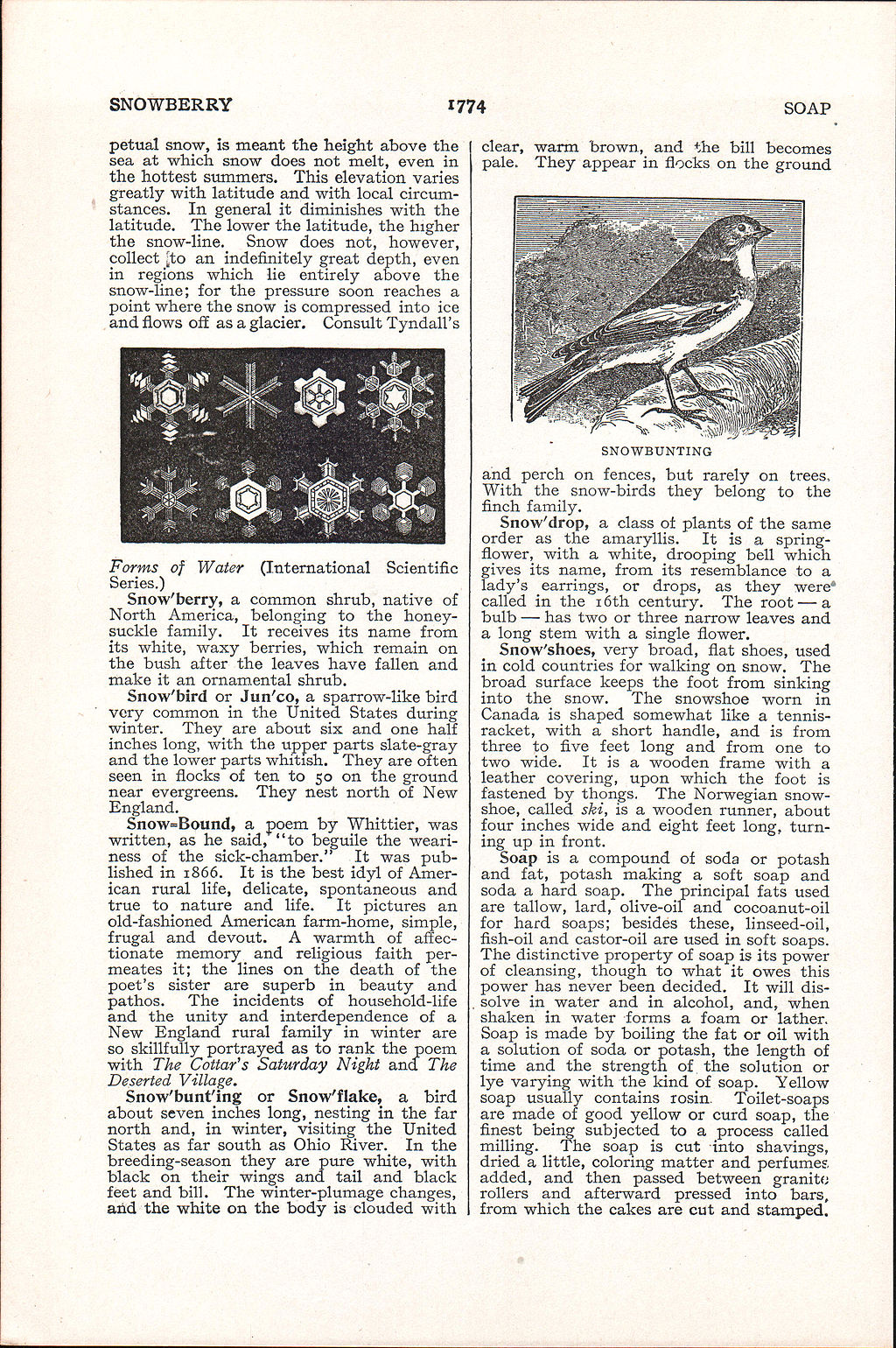SNOWBERRY
1774
SOAP
petual snow, is meant the height above the sea at which snow does not melt, even in the hottest summers. This elevation varies greatly with latitude and with local circumstances. In general it diminishes with the latitude. The lower the latitude, the higher the snow-line. Snow does not, however, collect [to a,n indefinitely great depth, even in regions which lie entirely above the snow-line; for the pressure soon reaches a point where the snow is compressed into ice and flows ofE as a glacier. Consult Tyndall's
Forms of Water (International Scientific Series.)
Snow'berry, a common shrub, native of North America, belonging to the honeysuckle family. It receives its name from its white, waxy berries, which remain on the bush after the leaves have fallen and make it an ornamental shrub.
Snow'bird or Jun'co, a sparrow-like bird very common in the United States during winter. They are about six and one half inches long, with the upper parts slate-gray and the lower parts whitish. They are often seen in flocks of ten to 50 on the ground near evergreens. They nest north of New England.
Snow=Boimd, a poem by Whittier, was written, as he said, "to beguile the weariness of the sick-chamber." It was published in 1866. It is the best idyl of American rural life, delicate, spontaneous and true to nature and life. It pictures an old-fashioned American farm-home, simple, frugal and devout. A warmth of affectionate memory and religious faith permeates it; the lines on the death of the poet's sister are superb in beauty and pathos. The incidents of household-life and the unity and interdependence of a New England rural family in winter are so skillfully portrayed as to rank the poem with The Cottar's Saturday Night and The Deserted Village.
Snow'bunt'ing or Snow'flake, a bird about seven inches long, nesting in the far north and, in winter, visiting the United States as far south as Ohio River. In the breeding-season they are pure white, with black on their wings and tail and black feet and bill. The winter-plumage changes, arid the white on the body is clouded with
clear, warm brown, and the bill becomes pale. They appear in flocks on the ground
SNOWBUNTING
and perch on fences, but rarely on trees, With the snow-birds they belong to the finch family.
Snow'drop, a class of plants of the same order as the amaryllis. It is a spring-flower, with a white, drooping bell which gives its name, from its resemblance to a lady's earrings, or drops, as they were* called in the 16th century. The root — a bulb — has two or three narrow leaves and a long stem with a single flower.
Snow'shoes, very broad, flat shoes, used in cold countries for walking on snow. The broad surface keeps the foot from sinking into the snow. The snowshoe worn in Canada is shaped somewhat like a tennis-racket, with a short handle, and is from three to five feet long and from one to two wide. It is a wooden frame with a leather covering, upon which the foot is fastened by thongs. The Norwegian snow-shoe, called ski, is a wooden runner, about four inches wide and eight feet long, turning up in front.
Soap is a compound of soda or potash and fat, potash making a soft soap and soda a hard soap. The principal fats used are tallow, lard, olive-oil and cocoanut-oil for hard soaps; besides these, linseed-oil, fish-oil and castor-oil are used in soft soaps. The distinctive property of soap is its power of cleansing, though to what it owes this power has never been decided. It will dissolve in water and in alcohol, and, when shaken in water forms a foam or lather. Soap is made by boiling the fat or oil with a solution of soda or potash, the length of time and the strength of the solution or lye varying with the kind of soap. Yellow soap usually contains rosin. Toilet-soaps are made of good yellow or curd soap, the finest being subjected to a process called milling. The soap is cut into shavings, dried a little, coloring matter and perfumes added, and then passed between granito rollers and afterward pressed into bars, from which the cakes are cut and stamped.
